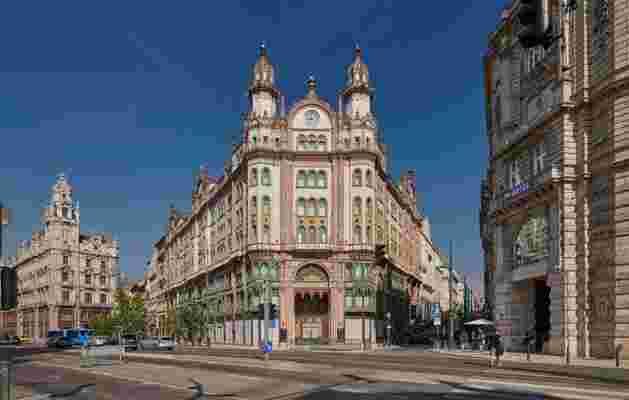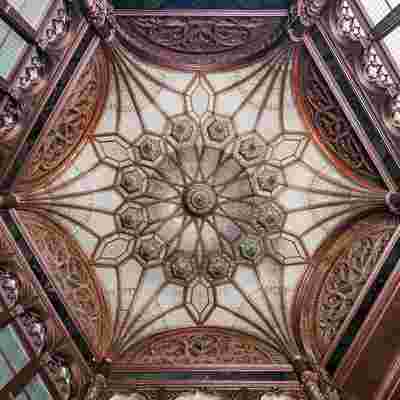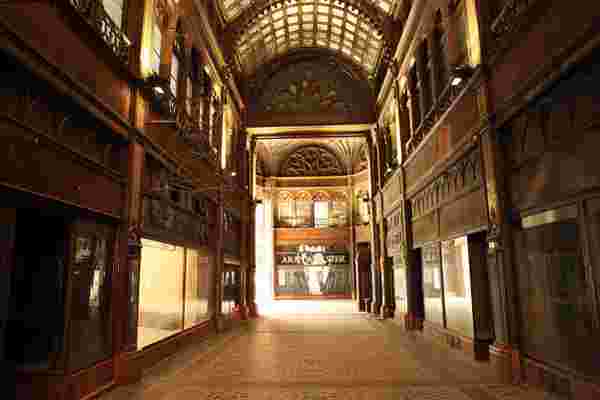When Hungarian architecture firm Archikon was tasked with transforming a monumental but faded Belle Epoque beauty in Budapest into a luxury hotel, the ornate historical landmark needed far more than a face-lift. Years of neglect and misguided mid-20th-century renovations had left the once glittering 100-year-old site—first designed as a glass-roofed shopping arcade—as a dusty, darkened, largely uninhabitable vestige of its former self. Some of the only use the space got over the past decade was as a Hollywood setting for Eastern European spy movies. The last tenants, an ice cream shop and a travel agent, vacated when the property was taken over by Hungarian hospitality firm Mellow Mood Hotels in 2014. But over the course of four and a half years, with the help of a vast team of preservationists, artisans, and engineers, as well as Budapest-based design firm Kroki, the Párisi Udvar has been restored to its former glory, and then some. The 126,000-square-foot hotel, which added more than 12,000 square feet to its interior, opened for business this past summer as part of Hyatt’s Unbound Collection, operated by Mellow Mood Hotels.
If the hotel has all the modern amenities expected by well-heeled travelers, including examples of contemporary Hungarian craftsmanship in the rooms, it also has the power to transport guests to the lavish days of the Austro-Hungarian Empire (1867–1918). Under the Dual Monarchy, Hungary’s explosion of wealth poured into Budapest’s architecture, as the country sought to erect an imperial capital to rival Vienna. First built in 1817 as a neoclassical shopping arcade, likely modeled after the famous Passage des Panoramas in Paris, the Párisi Udvar, then called the Brudern House, was rebuilt between 1909 and 1913 by a Hungarian bank in need of spiffy new headquarters. Most of the original structure was demolished and rebuilt, and bank offices and apartments were added upstairs. In the spirit of the era, something splashy was in order, resulting in a mix of Art Deco, Neo-Gothic, Moorish, and Art Nouveau details, with enough ceramic, metal, and wood ornamentation to adorn a town, let alone a building. With its glass domes, turrets, tiled façade, and gargoyles, it’s the kind of exquisite historical confection that once prompted the late, great chef and cultural observer Anthony Bourdain to describe Budapest’s architecture as “building porn.”

The building's ornate exterior.
Although the Párisi Udvar (or “Paris Court”) survived both World Wars, the building suffered when the Iron Curtain was drawn on Hungary after World War II, and some ghosts of its Soviet past still lingered. The façade was damaged during the revolution of 1956, and further travesties ensued during a renovation in the 1960s. In an attempt to stabilize the glass arcade, for instance, gobs of cement were applied to its steel framework, which eventually caused it to rust. All that steel had to be replaced while preserving the fragile glass panels within.

The stained glass ceiling.
Pólus and his team discovered a raft of curious surprises once demolition began. The original upper parts of the building, where there were apartments, had been poorly finished, he says, because the skilled workers finishing it were called off to fight in the Great War. The reconstruction also revealed that the early 20th-century reinforced concrete foundation—one of the earliest examples of the technology in Budapest—was too unstable to meet the modern building’s load-bearing needs, including the addition of more rooms and a new floor with the largest hotel suite in Budapest. “It was pioneering at the time, but the quality was terrible,” says Pólus. “So, we had to manage to strengthen the structure in a way that didn’t change the look of the building.”

The interiors as seen in 2014, prior to the renovation.
Not all of the discoveries were setbacks. “The biggest surprise was when we found more than one hundred original ceramics produced by [porcelain manufacturer] Zsolnay,” says Mellow Mood Hotels director Judit Blandl, explaining that the sculptures were hidden in an inaccessible area of the building. Of the 250,000 ceramic forms adorning the building—ranging from small green tiles and floral forms to dragon heads and human figures—nearly a quarter had to be remade by the Zsolnay factory, says Pólus. The biggest challenge there, he says, was matching the discolored glazes.
Detailing on the tilework.
Fortunately, many archival photos and plans still exist, so details could be accurately rebuilt. The transformation of the glass domes is especially noteworthy: One is lined with hundreds of delicate stained glass panels made by Hungarian master Miksa Roth, while the other is constructed of Luxfer glass prism tiles that had become blackened with dirt. They now let glittering light into the hotel.
The ultimate resource for design industry professionals, brought to you by the editors of Architectural Digest
“The reconstruction lasted longer than building the original building,” says Pólus, who notes the scarcity of skilled artisans and restorers working in the 21st century. For that reason alone, the Párisi Udvar might turn more heads today than it did a hundred years ago.
